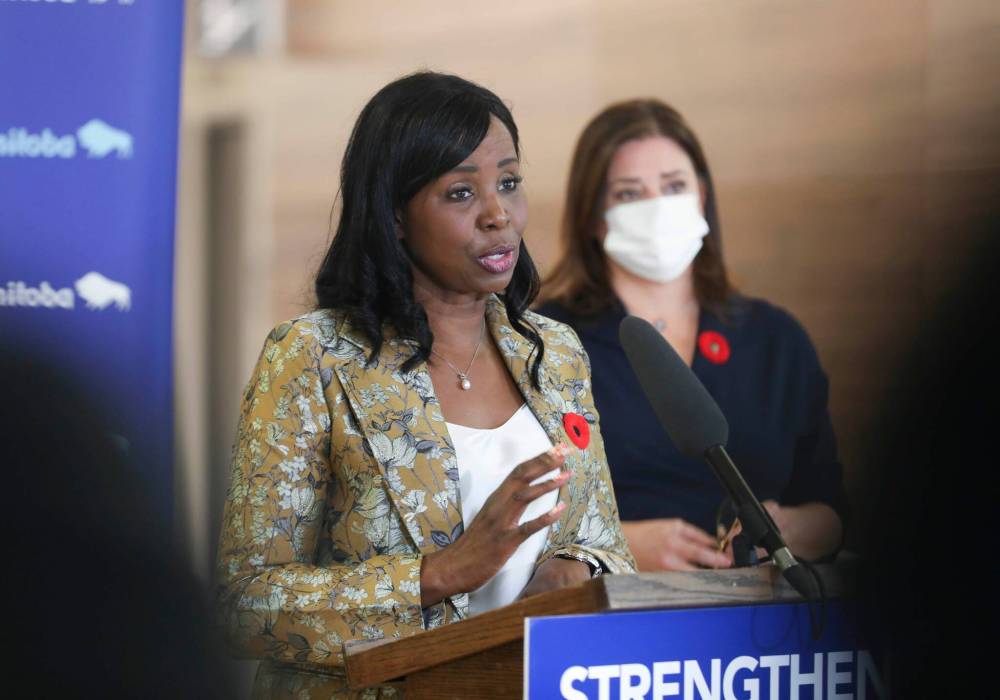Stefanson, Gordon work without a ‘net,’ but Manitobans the ones in danger
Read this article for free:
or
Already have an account? Log in here »
To continue reading, please subscribe:
Monthly Digital Subscription
$0 for the first 4 weeks*
- Enjoy unlimited reading on winnipegfreepress.com
- Read the E-Edition, our digital replica newspaper
- Access News Break, our award-winning app
- Play interactive puzzles
*No charge for 4 weeks then price increases to the regular rate of $19.00 plus GST every four weeks. Offer available to new and qualified returning subscribers only. Cancel any time.
Monthly Digital Subscription
$4.75/week*
- Enjoy unlimited reading on winnipegfreepress.com
- Read the E-Edition, our digital replica newspaper
- Access News Break, our award-winning app
- Play interactive puzzles
*Billed as $19 plus GST every four weeks. Cancel any time.
To continue reading, please subscribe:
Add Free Press access to your Brandon Sun subscription for only an additional
$1 for the first 4 weeks*
*Your next subscription payment will increase by $1.00 and you will be charged $16.99 plus GST for four weeks. After four weeks, your payment will increase to $23.99 plus GST every four weeks.
Read unlimited articles for free today:
or
Already have an account? Log in here »
Hey there, time traveller!
This article was published 16/05/2023 (932 days ago), so information in it may no longer be current.
It’s a simple question that deserves a straightforward answer: what is the net change in the number of front-line workers employed in Manitoba’s health-care system?
Yet, it’s one the provincial government refuses to answer.
Premier Heather Stefanson pledged in November to add a net 2,000 front-line staff to the health-care system by spending $200 million. The only way to know if the premier is fulfilling that commitment is to calculate the number of staff hired since she made the promise and subtract those who have resigned or retired.
New hires should not include staff who were transferred from one health facility to another. And the net change should be measured based on full-time equivalency, to ensure an apples-to-apples comparison.
RUTH BONNEVILLE / WINNIPEG FREE PRESS FILES Health Minister Audrey Gordon.
The government has refused to provide any of those figures.
When asked last week, Health Minister Audrey Gordon responded in gibberish, as she often does.
“I believe that we are accountable to the public for the commitments we make as a government,” said Gordon. “Our commitment was to add… 2,000 more health professionals. We are providing the public with information on our achievements towards that goal, which is nearly 900 additional health professionals…. That is what I believe the public wants to know.”
No, the public wants to know the net number: new full-time equivalent hires less the number who have left. That’s called the “net” change. I believe you learn that in Grade 3 math class (maybe earlier, I’ve been out of the public school system for a while).
The Manitoba Association of Allied Health Care Professionals tracks new hires and terminations. The union released data last week showing that from November 2022 until March, there were 100 allied health workers hired and 151 terminations, for a net loss of 51.
If the union can track those numbers for its members, surely government can do it for the entire health-care workforce. However, if the net change is in the red, as it is for allied heath workers, it’s easy to see why officials are keeping those figures close to the vest.
However, if the net change is in the red, as it is for allied heath workers, it’s easy to see why officials are keeping those figures close to the vest.
Even more important than measuring the net change since last November is tracking the long-term trend. Manitobans got a glimpse of that for the nursing profession through a freedom of information request made public by the Opposition NDP this week. The data, provided by the Winnipeg Regional Health Authority, shows that between 2016 and 2022, the number of nurses working under the WRHA declined from 8,014 to 7,722, for a net loss of 292.
During the same period, Winnipeg’s population grew by 70,601.
The decline in per capita nurses is the main reason wait lists for medical procedures, such as surgery, are longer today than they were prior to the COVID-19 pandemic. Doctors can’t perform surgeries without nurses in operating rooms and on medical wards for post-surgical recovery.
The decline in per capita nurses is the main reason wait lists for medical procedures, such as surgery, are longer today than they were prior to the COVID-19 pandemic.
The wait list for knee surgery in Manitoba, for example, doubled to 2,416 patients in February (the most recent data available) from 1,195 the same month in 2019. The wait list for hip surgery has increased to 913 patients from 519 during the same period. The figures do not include the number of patients waiting to see a specialist, which government does not track.
While surgical volumes have returned to pre-pandemic levels, they haven’t kept pace with the estimated five per cent annual growth in demand for hip and knee surgery. With fewer nurses in the system, it’s almost impossible to keep up with that growing demand. Given an aging population, that challenge is expected to become more pronounced over time.
RUTH BONNEVILLE / WINNIPEG FREE PRESS FILES Premier Heather Stefanson pledged in November to add a net 2,000 front-line staff to the health-care system by spending $200 million.
Some of today’s nursing shortage was driven by the pandemic itself, owing to workplace burnout and early retirements. However, much of it occurred prior to 2020 when the Tory government began cutting hospital budgets and consolidating health-care facility operations in Winnipeg six years ago.
Stefanson’s response to the nursing numbers released this week was no better than Gordon’s double-talk. The premier continued to repeat, like a broken record, that her government is spending $200 million to recruit health-care workers and that the province has hired 259 more nurses since November. What she won’t say is how many nurses quit or retired during that period.
Until government officials report both sides of the staffing ledger, the workforce numbers they release are meaningless.
tom.brodbeck@freepress.mb.ca

Tom Brodbeck is an award-winning author and columnist with over 30 years experience in print media. He joined the Free Press in 2019. Born and raised in Montreal, Tom graduated from the University of Manitoba in 1993 with a Bachelor of Arts degree in economics and commerce. Read more about Tom.
Tom provides commentary and analysis on political and related issues at the municipal, provincial and federal level. His columns are built on research and coverage of local events. The Free Press’s editing team reviews Tom’s columns before they are posted online or published in print – part of the Free Press’s tradition, since 1872, of producing reliable independent journalism. Read more about Free Press’s history and mandate, and learn how our newsroom operates.
Our newsroom depends on a growing audience of readers to power our journalism. If you are not a paid reader, please consider becoming a subscriber.
Our newsroom depends on its audience of readers to power our journalism. Thank you for your support.














